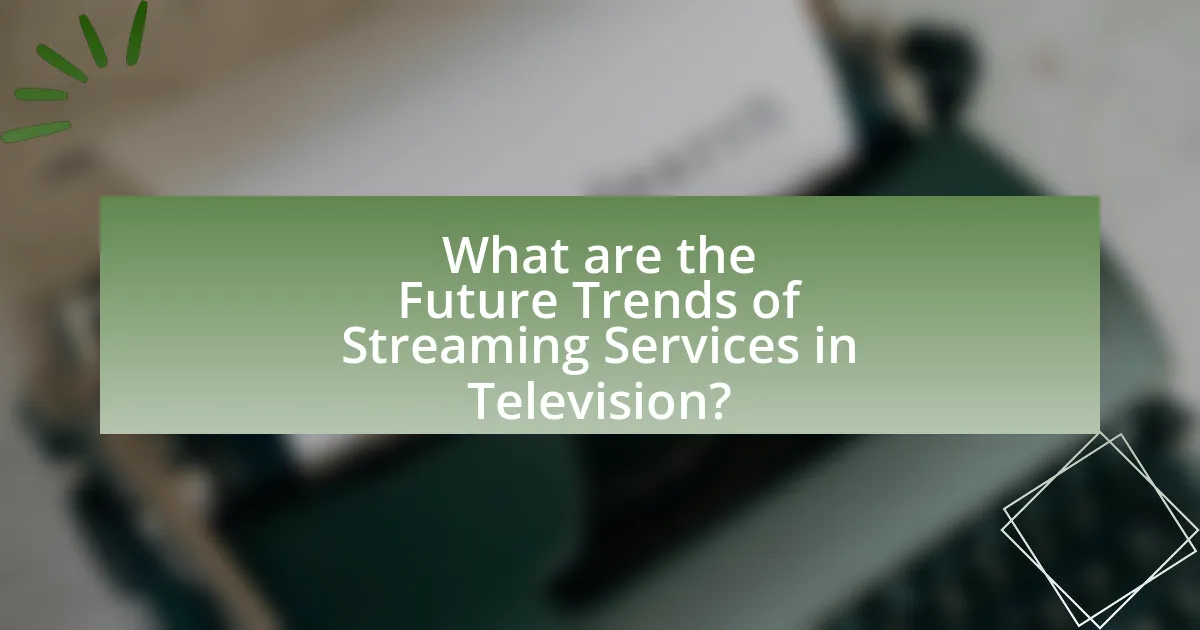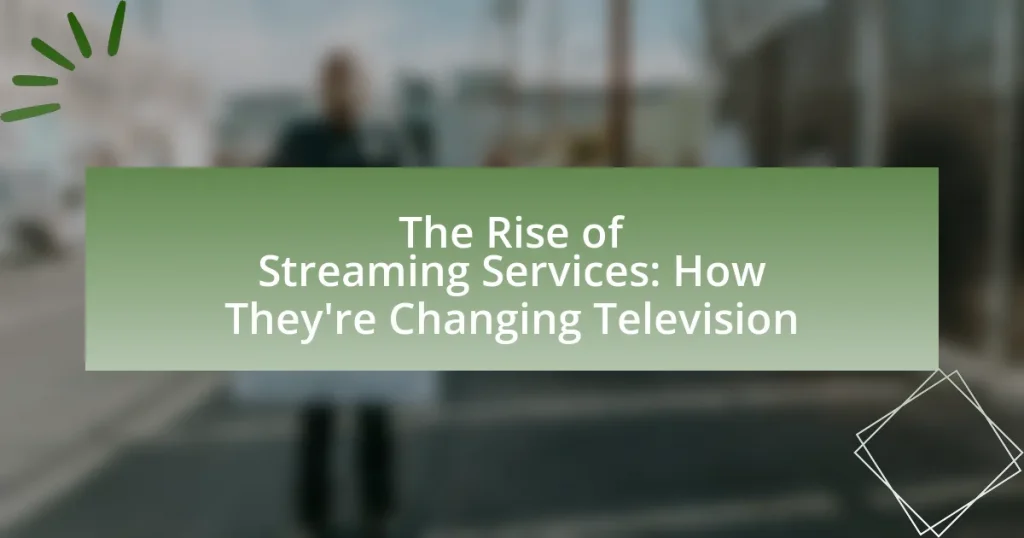Streaming services are digital platforms that provide on-demand video content over the internet, significantly transforming television consumption patterns. As of 2023, over 80% of U.S. households subscribe to at least one streaming service, leading to a decline in traditional cable subscriptions and a shift towards diverse programming and original series. The article explores the evolution of streaming services, the technological advancements that support their rise, and the implications for traditional television networks, including changes in advertising strategies and content creation. Additionally, it discusses future trends in streaming, such as increased personalization and the integration of live content, while offering strategies for consumers to optimize their streaming experience.

What are Streaming Services and Their Impact on Television?
Streaming services are digital platforms that deliver video content over the internet, allowing users to watch shows and movies on-demand. Their impact on television has been profound, leading to a significant shift in viewing habits; for instance, as of 2023, over 80% of U.S. households subscribe to at least one streaming service, according to the Leichtman Research Group. This shift has resulted in the decline of traditional cable subscriptions, with many viewers opting for the flexibility and variety offered by streaming platforms. Furthermore, streaming services have transformed content creation, encouraging the production of diverse programming and original series, which has reshaped the competitive landscape of the television industry.
How have streaming services evolved over the years?
Streaming services have evolved significantly over the years, transitioning from DVD rental models to comprehensive digital platforms. Initially, services like Netflix began as DVD rental by mail in 1997, but by 2007, they introduced streaming, marking a pivotal shift in content consumption. This evolution accelerated with the launch of platforms such as Hulu in 2008 and Amazon Prime Video in 2011, which expanded the variety of available content and introduced original programming. By 2020, the streaming landscape saw the emergence of Disney+, Apple TV+, and HBO Max, further diversifying options for consumers. According to a report by Statista, as of 2023, over 1.5 billion people globally subscribe to streaming services, highlighting their dominance in the entertainment industry.
What technological advancements have facilitated the rise of streaming services?
Technological advancements such as high-speed internet, cloud computing, and mobile devices have facilitated the rise of streaming services. High-speed internet allows for seamless video playback and reduces buffering, enabling users to access content instantly. Cloud computing provides the infrastructure for storing and delivering vast libraries of content efficiently, while mobile devices enable users to stream on-the-go, increasing accessibility. According to a report by Cisco, global internet traffic from video streaming is expected to account for 82% of all consumer internet traffic by 2022, highlighting the significant impact of these technologies on the streaming landscape.
How have consumer preferences shifted towards streaming services?
Consumer preferences have shifted significantly towards streaming services due to their convenience, variety, and cost-effectiveness. Research indicates that as of 2023, over 80% of U.S. households subscribe to at least one streaming service, reflecting a marked decline in traditional cable subscriptions, which have dropped by approximately 25% since 2015. This shift is driven by the ability to access on-demand content across multiple devices, allowing viewers to watch shows and movies at their convenience. Additionally, streaming platforms offer diverse content libraries, including original programming, which attracts a broader audience. The trend is further supported by the increasing availability of high-speed internet and the proliferation of smart devices, making streaming more accessible than ever.
What are the key features of popular streaming services?
Key features of popular streaming services include on-demand content access, subscription-based models, and original programming. On-demand content allows users to watch shows and movies at their convenience, which has become a standard expectation among viewers. Subscription-based models, such as those used by Netflix and Hulu, provide unlimited access to a library of content for a monthly fee, eliminating the need for traditional cable subscriptions. Additionally, original programming, exemplified by Netflix’s “Stranger Things” and Amazon Prime’s “The Marvelous Mrs. Maisel,” attracts subscribers by offering exclusive content that cannot be found elsewhere. These features collectively contribute to the growing popularity and transformative impact of streaming services on television consumption.
How do subscription models differ among streaming platforms?
Subscription models among streaming platforms differ primarily in pricing structures, content access, and user experience. For instance, platforms like Netflix offer tiered pricing based on video quality and the number of simultaneous streams, while Disney+ provides a flat rate for all content, including exclusive releases. Additionally, Amazon Prime Video combines its streaming service with other Amazon benefits, creating a bundled subscription model. Hulu, on the other hand, offers both ad-supported and ad-free options, allowing users to choose based on their preferences. These variations reflect the platforms’ strategies to attract different audience segments and maximize subscriber retention.
What types of content are most commonly available on streaming services?
Streaming services most commonly offer a variety of content types, including movies, television series, documentaries, and original programming. Movies encompass a wide range of genres, from action to romance, while television series often include both scripted shows and reality programming. Documentaries cover topics such as nature, history, and social issues, providing educational content. Original programming, unique to each service, has gained popularity, with platforms like Netflix and Amazon Prime producing exclusive series that attract large audiences. According to a 2021 report by Statista, over 50% of U.S. households subscribed to at least one streaming service, highlighting the demand for diverse content offerings.

How are Streaming Services Changing the Television Landscape?
Streaming services are transforming the television landscape by shifting viewer consumption from traditional cable to on-demand content. This change is evidenced by the rapid growth of platforms like Netflix, which had over 230 million subscribers globally by 2023, indicating a significant shift in how audiences access and engage with television programming. Additionally, streaming services offer personalized viewing experiences through algorithms that recommend content based on user preferences, further enhancing viewer engagement and satisfaction. The rise of original programming on these platforms, such as critically acclaimed series like “The Crown” and “Stranger Things,” has also disrupted traditional television networks, compelling them to adapt their strategies to retain audiences.
What are the implications of streaming services on traditional television networks?
Streaming services significantly disrupt traditional television networks by altering viewer consumption patterns and revenue models. The rise of platforms like Netflix and Hulu has led to a decline in cable subscriptions, with a 2021 report indicating that U.S. cable TV subscriptions fell by 6% compared to the previous year. This shift forces traditional networks to adapt by investing in their own streaming services or risk losing audience share. Additionally, streaming services often provide ad-free experiences, which challenges traditional networks’ advertising revenue, as advertisers increasingly shift their budgets to digital platforms. The implications extend to content creation, as streaming services prioritize original programming, compelling traditional networks to innovate and diversify their offerings to retain viewers.
How have advertising strategies changed with the rise of streaming services?
Advertising strategies have shifted significantly due to the rise of streaming services, moving from traditional television commercials to targeted digital advertising. Streaming platforms like Netflix, Hulu, and Disney+ have introduced subscription models that often limit or eliminate ads, prompting advertisers to focus on data-driven approaches that leverage viewer preferences and behaviors. For instance, platforms such as Hulu and Peacock offer ad-supported tiers, allowing advertisers to utilize audience segmentation and personalized ads based on user data, which enhances engagement and effectiveness. According to a 2021 report by eMarketer, digital ad spending in the streaming sector is projected to reach $20 billion by 2024, illustrating the growing importance of these strategies in the advertising landscape.
What challenges do traditional networks face in adapting to streaming trends?
Traditional networks face significant challenges in adapting to streaming trends, primarily due to their established business models and viewer habits. These networks rely on advertising revenue tied to scheduled programming, which conflicts with the on-demand nature of streaming services that prioritize viewer flexibility. Additionally, traditional networks struggle with the rapid technological advancements required to compete with streaming platforms, which often offer superior user experiences, such as personalized content recommendations and seamless multi-device access.
Moreover, the shift in audience demographics, particularly among younger viewers who prefer streaming over traditional television, poses a threat to traditional networks’ market share. According to a Nielsen report, as of 2021, streaming accounted for over 28% of total television viewing time in the U.S., highlighting the urgency for traditional networks to innovate. These factors collectively hinder traditional networks from effectively transitioning to a streaming-centric model.
How do streaming services influence content creation and distribution?
Streaming services significantly influence content creation and distribution by prioritizing data-driven decision-making and enabling diverse storytelling. These platforms analyze viewer preferences and engagement metrics to inform the types of content produced, leading to a rise in niche genres and original programming. For instance, Netflix reported that its investment in original content, which reached $17 billion in 2020, was largely guided by viewer data, resulting in successful series like “Stranger Things” and “The Crown.” Additionally, streaming services have disrupted traditional distribution models by allowing for immediate global access to content, as seen with Amazon Prime Video’s simultaneous release of films and series worldwide, which contrasts with the staggered releases typical of traditional television networks. This shift not only enhances audience reach but also encourages creators to experiment with formats and storytelling techniques that cater to diverse global audiences.
What role do original productions play in attracting subscribers?
Original productions are crucial in attracting subscribers to streaming services. They create unique content that differentiates a platform from its competitors, drawing in viewers who seek exclusive shows and films. For instance, Netflix’s original series like “Stranger Things” and “The Crown” have significantly contributed to subscriber growth, with reports indicating that original content is a primary reason for 70% of new sign-ups. This strategy not only enhances subscriber retention but also fosters brand loyalty, as consumers are more likely to remain subscribed to access new and original offerings.
How has the global reach of streaming services affected local content production?
The global reach of streaming services has significantly increased competition for local content production. As international platforms like Netflix and Amazon Prime Video expand their audiences, they often invest in local productions to cater to diverse markets, which can elevate the quality and visibility of regional content. For instance, Netflix’s investment in local productions in countries like India and South Korea has led to a surge in high-quality series and films that resonate with local audiences while also gaining international acclaim. This trend has prompted local producers to innovate and adapt, often resulting in a richer variety of content that reflects cultural narratives and preferences.

What are the Future Trends of Streaming Services in Television?
The future trends of streaming services in television include increased personalization through advanced algorithms, the rise of ad-supported models, and the expansion of live streaming capabilities. Streaming platforms are leveraging data analytics to tailor content recommendations, enhancing user engagement; for instance, Netflix’s recommendation system accounts for over 80% of the content watched on the platform. Additionally, ad-supported streaming services are gaining traction, with platforms like Peacock and Hulu reporting significant user growth, indicating a shift in consumer preferences towards lower-cost options. Furthermore, the integration of live sports and events into streaming services is becoming more prevalent, as seen with Amazon Prime Video’s acquisition of NFL Thursday Night Football rights, reflecting a broader trend of merging traditional broadcasting with streaming.
How might technology shape the future of streaming services?
Technology will significantly shape the future of streaming services by enhancing user experience through advancements in artificial intelligence, cloud computing, and 5G connectivity. Artificial intelligence will enable personalized content recommendations, improving viewer engagement; for instance, Netflix uses algorithms to analyze user behavior and suggest shows, resulting in higher retention rates. Cloud computing will facilitate seamless streaming and storage, allowing services to scale efficiently and provide high-quality content without buffering. Additionally, the rollout of 5G technology will enhance streaming quality and accessibility, enabling users to stream high-definition content on mobile devices with minimal latency. These technological advancements are already transforming how audiences consume media, indicating a future where streaming services become even more integral to entertainment consumption.
What innovations are expected to enhance user experience in streaming?
Innovations expected to enhance user experience in streaming include advanced algorithms for personalized content recommendations, improved streaming quality through adaptive bitrate technology, and the integration of augmented reality (AR) and virtual reality (VR) features. Personalized content recommendations utilize machine learning to analyze user preferences, resulting in a more tailored viewing experience. Adaptive bitrate technology adjusts video quality in real-time based on internet speed, ensuring smoother playback. Furthermore, AR and VR features are being developed to create immersive viewing experiences, allowing users to engage with content in new ways. These innovations are supported by industry trends indicating a growing demand for personalized and high-quality streaming experiences, as evidenced by the increasing investment in technology by major streaming platforms.
How will data analytics influence content recommendations and personalization?
Data analytics will significantly enhance content recommendations and personalization by leveraging user data to tailor viewing experiences. Streaming services utilize algorithms that analyze user behavior, preferences, and engagement metrics to suggest content that aligns with individual tastes. For instance, Netflix employs a recommendation system that accounts for over 80% of the content watched on its platform, demonstrating the effectiveness of data-driven personalization. This approach not only increases user satisfaction but also boosts viewer retention, as personalized recommendations lead to longer viewing times and increased subscription loyalty.
What strategies can consumers adopt to maximize their streaming experience?
Consumers can maximize their streaming experience by optimizing their internet connection, selecting the right subscription plans, and utilizing device capabilities effectively. A stable and high-speed internet connection, ideally with at least 25 Mbps for HD streaming, ensures smooth playback without buffering. Choosing subscription plans that offer the desired content and features, such as ad-free viewing or offline downloads, enhances user satisfaction. Additionally, utilizing devices that support the latest streaming technologies, such as 4K resolution and HDR, can significantly improve visual quality. According to a report by Deloitte, 80% of consumers prioritize content variety and quality, indicating that these strategies directly impact overall streaming enjoyment.
How can viewers choose the best streaming service for their needs?
Viewers can choose the best streaming service for their needs by evaluating content availability, pricing, user interface, and device compatibility. Content availability is crucial; for instance, services like Netflix offer a wide range of original programming, while others may focus on specific genres or networks. Pricing varies significantly, with options ranging from ad-supported tiers to premium subscriptions, making it essential for viewers to consider their budget. User interface affects the overall experience; a service with an intuitive design can enhance content discovery. Lastly, device compatibility ensures that viewers can access their chosen service on their preferred devices, such as smart TVs, tablets, or smartphones. By assessing these factors, viewers can make informed decisions that align with their viewing preferences and habits.
What are some tips for managing multiple streaming subscriptions effectively?
To manage multiple streaming subscriptions effectively, create a centralized tracking system to monitor subscription costs, renewal dates, and content availability. This approach allows users to avoid overlapping subscriptions and unnecessary expenses. For instance, utilizing a spreadsheet or a dedicated app can help users visualize their subscriptions and set reminders for cancellations or renewals. Additionally, regularly reviewing content libraries ensures that users are subscribed to services that provide the shows and movies they actually watch, optimizing their entertainment budget. According to a 2021 survey by Deloitte, 61% of consumers reported feeling overwhelmed by the number of streaming options, highlighting the importance of effective management strategies.




